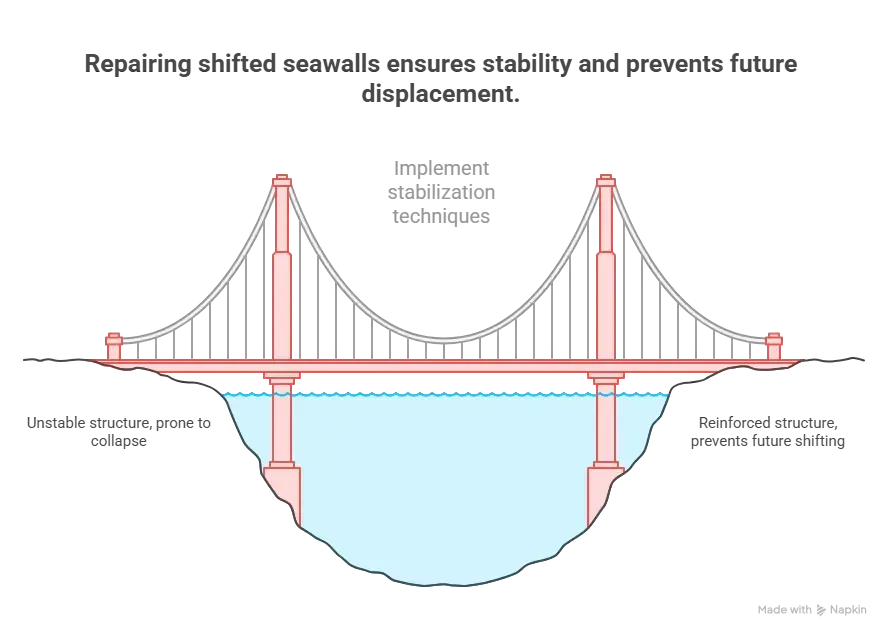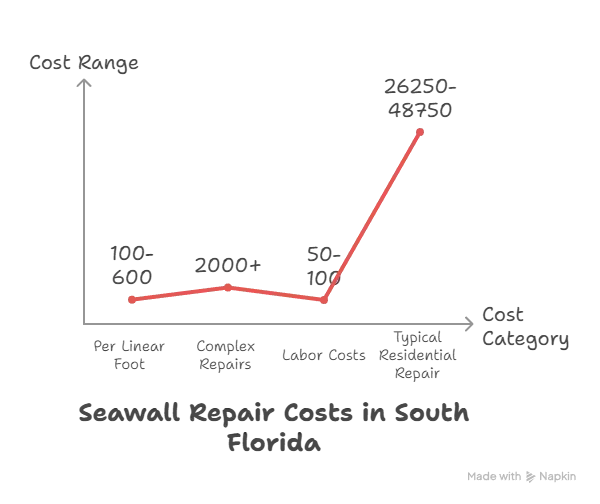A shifted seawall is a critical structural issue where the protective barrier along a coastline or waterway has moved from its original position, often due to a combination of environmental and structural factors.
The primary causes for such shifts include hydrostatic pressure buildup from water accumulation, soil erosion and settlement undermining the foundation, severe weater conditions like hurricanes, and poor foundation engineering.
Repairing a shifted seawall involves specialized methods focused on stabilization, reinforcement, and soil consolidation.
The costs associated with these repairs, particularly in areas like Florida, can range significantly depending on the extent of damage and the complexity of the intervention required.
How to Repair a Shifted Seawall?

Repairing a shifted seawall requires a comprehensive assessment and professional intervention using specialized stabilization techniques. The repair process begins with identifying the extent of displacement and underlying causes, followed by implementing structural reinforcement methods to restore stability and prevent further movement.
Professional seawall repair specialists employ steel tiebacks and anchoring systems to secure leaning or shifted seawalls back into proper position. These reinforcements work in conjunction with soil stabilization techniques to ensure long-term structural integrity. Contractors also utilize curtain grouting methods to stabilize surrounding soil and prevent future shifting, creating a comprehensive solution that addresses both immediate displacement and underlying instability issues.
What Are the Causes to Repair a Shifted Seawall?
Several environmental and structural factors contribute to seawall shifting, requiring professional repair intervention. Understanding these seawall shifting causes helps property owners recognize when immediate action becomes necessary to prevent catastrophic failure.
The primary seawall shifting causes include:
- Hydrostatic pressure buildup from water accumulation behind the seawall creates excessive force that pushes against the structure
- Soil erosion and settlement undermines the foundation, causing uneven support and gradual displacement
- Severe weather conditions including hurricanes, storms, and high tides exert tremendous pressure on seawall structures
- Poor foundation engineering with inadequate depth or improper soil stabilization leads to structural instability
- Saltwater corrosion degrades steel reinforcement within concrete, causing expansion and cracking that weakens the overall structure
- Inadequate drainage systems allow water to pool behind seawalls, increasing hydrostatic pressure and soil saturation
What Are the Shifted Seawall Repair Methods?
Modern shifted seawall repair in South Florida employs multiple specialized methods designed to address structural displacement and prevent future movement. These techniques focus on stabilization, reinforcement, and soil consolidation to restore structural integrity.
Key seawall repair methods include:
- Steel tieback installation secures shifted seawalls using anchoring rods that extend deep into stable soil or bedrock
- Curtain grouting creates a barrier behind seawalls to prevent water infiltration and soil erosion
- Epoxy resin reinforcement provides structural strength repairs to concrete cracks and spalling damage
- Soil stabilization injection consolidates loose earth and prevents further settlement beneath seawall foundations
- Secondary anchor systems provide additional structural support for walls showing signs of movement
How Much Does It Cost to Repair a Seawall in Florida?

Seawall repair costs in South Florida range from $100 to $600 per linear foot, with the average project costing homeowners $37,500. Complex repairs involving significant structural damage can reach $2,000 per linear foot or higher depending on environmental conditions and access requirements.
Florida-specific factors influence pricing significantly due to the state’s challenging coastal environment. Saltwater exposure requires more expensive corrosion-resistant materials, while hurricane-prone conditions demand stronger reinforcement systems. To repair shifted seawall, labor costs average $50 to $100 per hour for specialized marine contractors, with skilled technicians commanding premium rates due to the technical expertise required.
Property owners should budget between $26,250 and $48,750 for typical residential shifted seawall repair in South Florida, though emergency repairs following storm damage often exceed these estimates due to urgent timeline requirements and limited contractor availability.
Want the full cost picture? Check out our detailed blog on seawall pricing in South Florida for a complete breakdown.
What Are the Common Seawall Repair Techniques Used in Florida?
Florida seawall repair contractors primarily utilize hybrid reinforcement systems, which are tailored to the state’s unique coastal conditions. These techniques address the specific challenges posed by saltwater exposure, hurricane forces, and sandy soil conditions prevalent throughout Florida’s coastline.
The most common techniques include:
- Marine-grade concrete patching repairs surface damage using materials specifically designed to resist saltwater corrosion
- Steel reinforcement with corrosion-resistant coatings prevents degradation in Florida’s harsh marine environment
- Hybrid seawall designs combine hard structures with soft engineering solutions like mangroves and artificial reefs
- Soil densification techniques address Florida’s challenging sandy soils that shift during storms and tidal changes
Also read: Top 5 Seawall Repair Techniques in South Florida
What is the Life Expectancy of a Seawall?
A properly constructed and maintained seawall typically lasts 30 to 50 years, with material selection and maintenance practices significantly impacting longevity. Premium materials and regular upkeep can extend seawall life beyond these averages, while neglect or poor construction can lead to failure in as little as 10 to 20 years.
Seawall lifespan varies by construction material and environmental exposure. Vinyl seawalls offer the longest service life at 50 to 80+ years, while concrete seawalls provide 30 to 60 years of protection. Steel seawalls last 25 to 40 years, and wood seawalls serve 10 to 40 years depending on treatment and maintenance.
Florida’s challenging coastal environment, including saltwater exposure, hurricane forces, and temperature fluctuations, can reduce these lifespans without proper maintenance. Regular inspections, prompt crack repairs, and proper drainage maintenance help seawalls achieve their full life expectancy, while deferred maintenance can cut service life in half. Many older Florida seawalls built decades ago were designed with 30-year life expectancies and now require replacement or major rehabilitation as they reach the end of their design life.
Why Should You Choose Sea Me Dive for Seawall Repair Solutions in Florida?
You should choose Sea Me Dive for seawall repair because they provide underwater inspections and repairs that their surface-only competitors can’t, and deliver faster, lower-cost restorations by addressing hidden foundation damage while minimizing delays. Contact Sea Me Dive at 754-265-7115 or office@seamedive.net.
